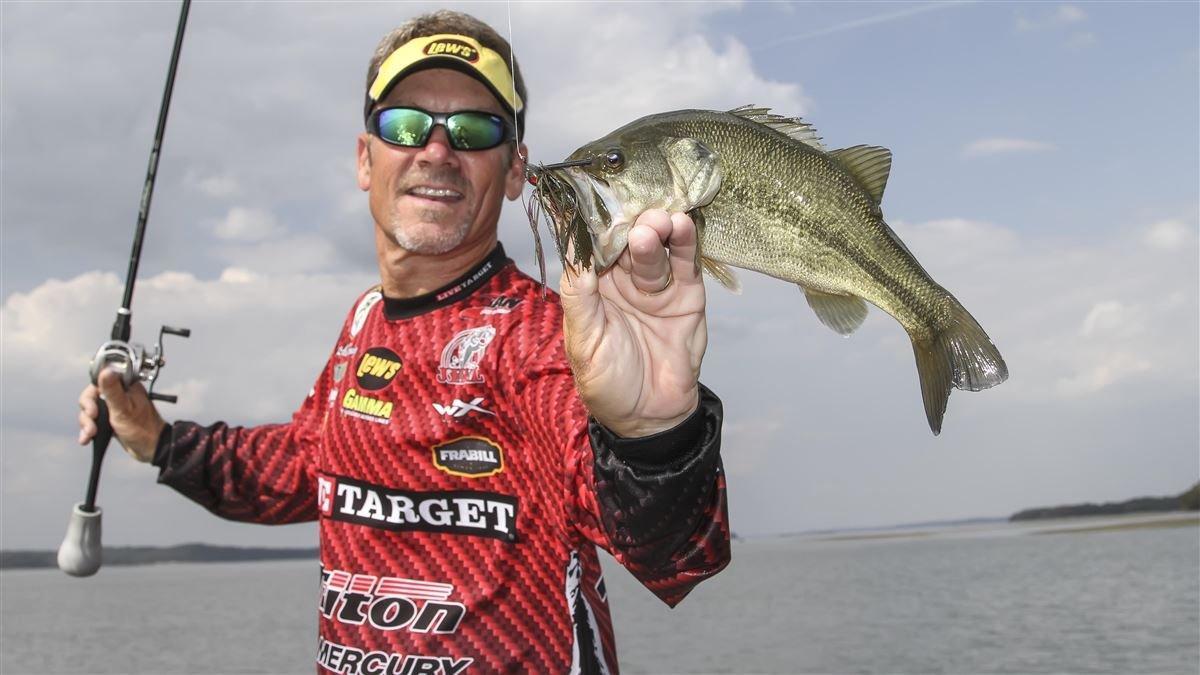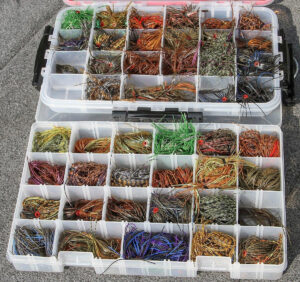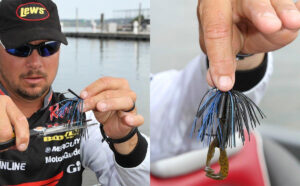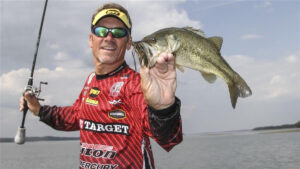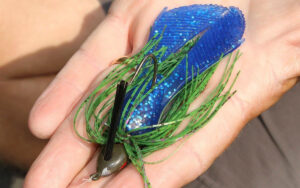Skirted jigs are meant to address motion and mimicry. Varying degrees of action enhance the lifelike appearance, while matching the colors of indigenous forage is always a smart strategy.
The range of discussions relevant to all the many facets of skirted jig construction, material and trailer matching can reach as deep as you want to go; but for our purposes here, consider these tips from some of bass fishing’s accomplished jig fishermen.
Figure out the forage
Bassmaster Elite Series pro Stephen Browning spends a lot of time behind his signature series Jewel Baits Magnum Casting jig and one of the key elements in his presentation is skirt color. The Arkansas pro likes to keep things simple, but he also maintains a diverse array of options.
“I choose to start out with three basic (skirt) colors: black-blue-purple, green pumpkin candy and green pumpkin-orange,” he explained. “What I’m trying to do is match the hatch. In early spring, I like to use crayfish colors (green pumpkin-orange) because the fish are feeding up on crayfish to build up that extra fat to get ready for the spawn.
“During the spawn, I like bluegill colors (green pumpkin candy) and then black-blue-purple works year-round. In the summer, I lean back toward the crawfish colors and then in the fall, I come back to the bluegill colors.”
Although this selection will get him through the year’s textbook scenarios, for those tougher times – weather changes, fishing pressure – Browning keeps his skirt tray well stocked with more locally-specific skirts. Knowing the local waters, he said, facilitates prudent selections.
“When I’m in the Ozarks, I might use an Ozark Craw skirt (black/emerald-pumpkin-chartreuse). In Florida waters, I want the green pumpkin-blue. Know that local forage and have several different colors with you.
“If you don’t have a lot of skirt colors, get some skirt material and add some (accent colors) to your skirts. If you catch a bass and you see crayfish pinchers or a bluegill tail sticking out of its gullet, get your pliers and pull that out of the fish’s mouth, see what color it is and then match that with your jig skirt.”
As Browning explains, accent strands like chartreuse, orange, purple captures those bream/sunfish shades, while various orange, red and brown strands commonly mimic crayfish.
Now, here’s a cool one from FLW Tour pro Terry Bolton: Sticking about an inch-long chunk of plastic worm on his jig’s hook shank provides a spacer that prevents his trailer from riding up and then turning outward to block his hook point. However, when that worm chunk bears a strong contrast to his skirt (i.e. chartreuse), that accent color stands out loud and proud when the jig hits the bottom and that skirt flares outward.
Trim to impress
Can you take a jig right out of the package, stick a trailer on the back and catch fish? Sure, sometimes that’s just fine. But, often a little hair cut’s in order.
Length
Lots of reasons for – and methods to – trim a jig; but to quickly hit this one, consider appearance and function. To the latter, Browning’s fellow Elite pro Jason Christie points out that shortening a jig skirt level with the hook bend keeps it from hindering the action of his trailer.
On the aesthetic side, Christie complements the barber style trim with a couple of angled snips to the skirt’s sideburns. This yields the “flare” that’s necessary for those lively presentations.
Thickness
In addition to matching the hatch, the Elite pro from Oklahoma knows that matching the seasonal scenario also impacts his jig’s effectiveness. Summarily, he wants a more active, enticing appearance when warmer water amps up the fish’s aggression; whereas the lethargy of cold – or excessively hot – temps necessitates a slower presentation.
Same goes for the tone of a particular day. Say it’s mid-spring and warming water temperatures have the fish ready to feed – until a late-season cold snap puts the kibosh on that deal.
The fish may still want to chew a little, but they’re gonna need some finessing. Decreasing skirt length and density is one of your tools for this task. (Ditto for the tapering influence of heavy fishing pressure.)
It’s all about understanding the fish’s disposition. When they’re in the mood to chase down a tempting meal, show them something that looks like it might make a run for it. If you know the fish aren’t up for the whole cardio thing, make it easy for them to catch what you’re throwing.
Essentially, the thinner your skirt, the faster the jig falls; while the greater drag of a full skirt slows that descent.
Flipping legend Denny Brauer adds to this notion by sizing his skirts according to his expectations for the lake he’s fishing. On his home waters of Amistad, or other beast factories like Falcon, Rayburn or Okeechobee, a full size skirt suits the big fish he’s seeking. On the other hand, fisheries with more modest top-end expectations will have him thinning and shortening those skirts to suit the locals.
Related modifications
Guarded ways
Now, amid all this talk of skirt alterations, FLW Tour pro Andrew Upshaw notes that he likes to thin the bottom half of his weed guard on his Outkast Tackle finesse jig. Reason: He throws this jig on a medium-action Lew’s Custom Speed Stick spinning rod, so thinning the weed guard helps him get a solid hook set.
For Brauer, weed guard trimming is more of a visual aid. Once he’s completed his jig prep routine (skirt trimming, eye clearing, hook point check, etc.), he’ll trim the top corner of his weed guard at a 45-degree angle to ensure that top edge continues to block snags. A quick glance in his jig box shows him which ones are ready to rumble.
Tied up
The consummate perfectionist, Texas Elite pro Gary Klein makes his own jig skirts and implements some good old-fashioned frugality along the way. Like most, he flips his braid – strips off the line and then respools from the opposite end for maximum use before replacing. But rather than dumping the thoroughly used line after a full cycle, he’ll save several yards of braid for use in binding those skirt strands.
Similarly, California pro Charlie Weyer secures his punch skirts with recycled braid.
Klein offers this operation advice: Use a spool and bobbin (available at fly fishing retailers) for precision application.


